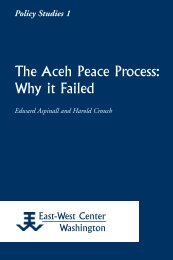Constructing Papuan Nationalism: History, Ethnicity ... - ScholarSpace
Constructing Papuan Nationalism: History, Ethnicity ... - ScholarSpace
Constructing Papuan Nationalism: History, Ethnicity ... - ScholarSpace
- No tags were found...
Create successful ePaper yourself
Turn your PDF publications into a flip-book with our unique Google optimized e-Paper software.
94 Richard Chauvel60. Protest Letter, Nicolaas Jouwe and Filemon T.J. Jufuway, Freedom Committee ofWest Papua / West New Guinea, to the President of the XIXth General Assemblyof the United Nations Organization, 20 November 1964, DEA file 30036/6/1part 84, NAA; see Chauvel and Ikrar Nusa Bhakti 2004: 14–15, 19–20 for a discussionof the Indonesian government’s attitude towards New York Agreementand the right of self-determination in the years following the signing of the agreement.61. “Most Urgent Appeal of the <strong>Papuan</strong>s of West New Guinea/ “West Irian” to HisExcellency the Secretary-General of the United Nations, New York, signed byNicholaas Jouwe and 9 other <strong>Papuan</strong> members of the “Freedom Committee ofWest Papua/West New Guinea”, Poptahof-Noord 299, Delft, The Netherlands, 19September 1967. The emphasis is Jouwe’s.62. Clemens Runaweri, “Political Situation in West Papua between May 1, 1963 andApril 11, 1969, and the “Act of Free Choice” in July – August 1969”, pp. 15,17–19. DEA file 3036/2/1 Pt. 16, CRS A1838 T 184, NAA. The emphasis isRunaweri’s.63. Note of Protest, The Freedom Committee of West Papua / West New Guinea tothe President of the XXIVth General Assembly and the Secretary General of theUN, 22 September 1969.64. Laporan Foreri, cited in “Gus Dur Minta ke MPR, Thom Bilang DialogInternasional”, Tifa Papua, 10–15 January 2000.65. Interview, Fritz Kirihio, Jakarta, 5 July 2003. It should be noted, however, that, asdiscussed below, Dutch officials thought there had already been a shift in sentimentagainst Indonesia in 1961–62.66. The clash Bonay refers to occurred on October 10, 1943, on a beach nearManswam, Biak. After repeated warnings, the Japanese fleet opened fire on themen, women and children who had gathered on the beach, believing that theyhad supernatural protection. The action left between 600 and 2,000 Biaks dead(Rutherford 2003: 200).67. Kamma 1972: 199–200. Danilyn Rutherford (personal communication, July2004) suggests that one of the factors in Kaisiepo’s changed position on Koreriwas the decision of the Synod of the Dutch Reformed Church (Hervormd Kerk)on 5 July 1956 to oppose <strong>Papuan</strong> independence and support Papua’s integrationinto Indonesia. This decision was a reversal of the Church’s position at the time ofPapua separation from the transfer of sovereignty to Indonesia in 1949 andmarked a significant stage in Kaisiepo’s development as a <strong>Papuan</strong> nationalist andas a Christian. See Kaisiepo’s account in Sharp and Kaisiepo 1994: 95–97;Appendix I: Kejataan Pendirian Dari Nieuw Guinea, 1956, pp. 119–21.68. In 1961, when he was serving as a member of the Komite Nasional and the NewGuinea Council, Kaisiepo supported Papua as the name of the territory.Nevertheless, in the course of the discussions he recalled his earlier argument that“Papua” was considered derogatory. According to Kaisiepo, the term had onlybeen used by seafarers for the western coastal areas and the islands off the westerncoast, and it had not been applied to the mainland or the islands to the north. Heargued that the Indonesians had been clever in adopting “Irian” for their own referencesto the territory, because they knew <strong>Papuan</strong>s favored the term and that itsuse would make <strong>Papuan</strong>s more favorably deposed toward integration with
















